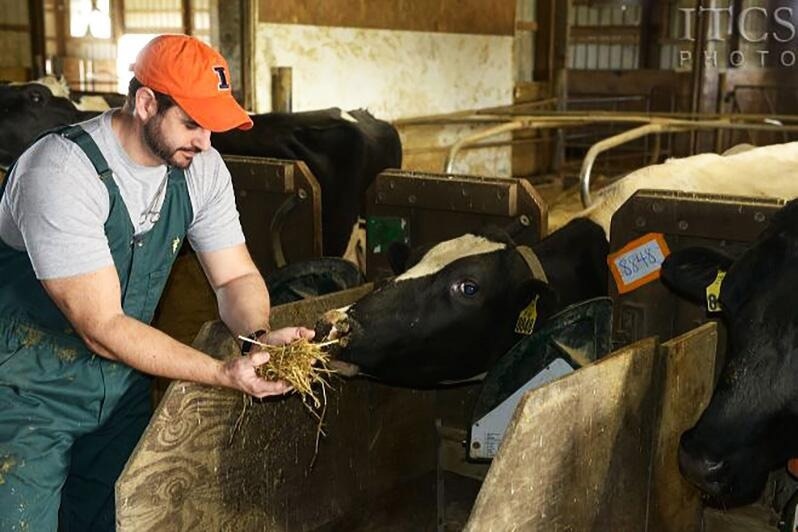Reviewed by Danielle Ellis, B.Sc.Sep 20 2022
Boosting milk yield when included in the diet at sufficient levels, lysine is an important amino acid for dairy cows. But how could lysine be advantageous for cows in other means? A new study by the University of Illinois reveals that rumen-protected lysine can enhance uterine health if given in the transition period.

Image Credit: University of Illinois
Right after calving, the uterus is undergoing a lot of changes. The cow had 100 pounds of calf, placenta, and fluids in there, but by 30-40 days after calving, the uterus has to shrink back down and get ready for the next pregnancy. There are a lot of cells regenerating, and the cow is potentially vulnerable to infection and inflammation at that time.”
Phil Cardoso, Associate Professor and Faculty Extension Specialist, Department of Animal Sciences, University of Illinois
For 28 days pre-calving, Cardoso and his research group included a rumen-protected lysine product to total mixed ration (TMR) at 0.54%. Post calving, for further 28 days, the lysine was included at 0.4%. Cows received the additive of lysine before or post calving, or both, and another control group consumed no lysine supplement in either of these periods.
We found genes involved with producing inflammatory proteins in the uterus were reduced with rumen-protected lysine, especially in cows that consumed the amino acid before and after calving. And genes involved in keeping the uterus clean were more active. Altogether, our results indicate less inflammation in these cows, meaning they can spend less energy defending against infection. It’s just more efficient.”
Phil Cardoso, Associate Professor and Faculty Extension Specialist, Department of Animal Sciences, University of Illinois
In addition to the gene expression characterization in the uterus, the research group searched for metritis evidence, which is a uterine infection that affects 30% of US dairy cows post calving. Although the whole inflammation status of the uterus improved with supplemental lysine, the scientists did not find a statistical difference in metritis in cows that were given lysine and those that were not.
Metritis is the clinical presentation of uterine inflammation. It requires a larger degree of challenge from the environment to show up. Perhaps our farm does not present real stress in that regard. We did find a difference in the sub-clinical form, also called subclinical endometritis. When we counted the number of inflammatory cells (PMN) in the uterus, cows receiving rumen-protected lysine had a lower number of cells, indicating less inflammation.”
Phil Cardoso, Associate Professor and Faculty Extension Specialist, Department of Animal Sciences, University of Illinois
The first postpartum follicular growth cycle in the ovaries was also tracked by the team. Lysine neither disturbed the time to first ovulation, which had an average of 18 days in milk for all groups, nor the follicular diameter at ovulation.
Cardoso is not amazed or upset that lysine did not affect ovulation. He states the uterus’ health right after calving is more essential than producers assume.
“When you ask farmers how they assess reproductive progress and fertility, the answer is always pregnancy. Usually farmers are breeding cows around 60 to 70 days after calving, but if it is unsuccessful, it’s often because of events like metritis or subclinical endometritis that happen prior to breeding, earlier in the cycle. This research shows rumen-protected lysine can set your cow up for success right after calving so she can achieve a favorable pregnancy later.”
The lysine effects line up with the previous work of Cardoso looking at rumen-protected methionine, which is another restricting amino acid in dairy cows. He revealed methionine-influenced genes related to inflammation and estrogen production and improved survival of the embryo.
“Our recommendation is to use both rumen-protected methionine and lysine,” states Cardoso. “We know both amino acids are limiting in dairy cows, but it’s not clear that standard dietary sources—corn or bloodmeal—make it through the rumen to supply cows with the amount they need.”
Cardoso states that nutritionists are beginning to know rumen-protected lysine and methionine products’ significance in the industry, even when they are not extensively integrated into commercial feeds.
“Nutritionists are the ones that come up with what's needed to get results, and they’re becoming aware of rumen-protected amino acid products. But we want to educate farmers, too, so they’ll be able to start the conversation with nutritionists. Asking, ‘Hey, is this something that could help me?’” concludes Cardoso.
Source:
Journal reference:
Guadagnin, A., et al. Effect of feeding rumen-protected lysine through the transition period on postpartum uterine health of dairy cows. Journal of Dairy Science. doi.org/10.3168/jds.2022-21934.